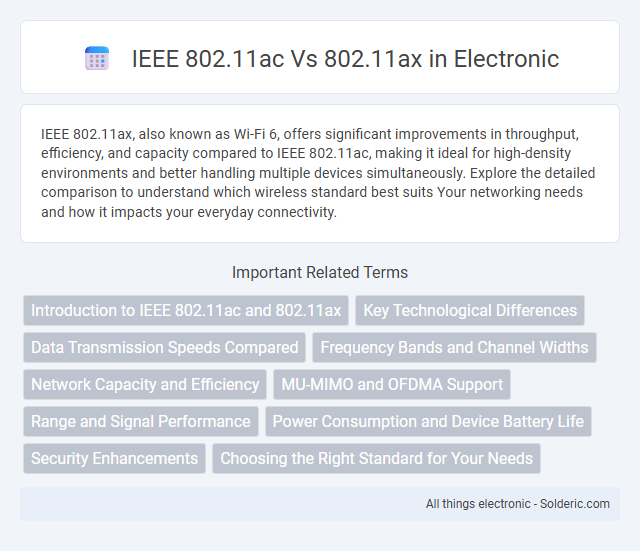IEEE 802.11ax, also known as Wi-Fi 6, offers significant improvements in throughput, efficiency, and capacity compared to IEEE 802.11ac, making it ideal for high-density environments and better handling multiple devices simultaneously. Explore the detailed comparison to understand which wireless standard best suits Your networking needs and how it impacts your everyday connectivity.
Comparison Table
| Feature | IEEE 802.11ac | IEEE 802.11ax |
|---|---|---|
| Frequency Bands | 5 GHz | 2.4 GHz & 5 GHz |
| Maximum Data Rate | Up to 3.5 Gbps | Up to 9.6 Gbps |
| Modulation | 256-QAM | 1024-QAM |
| MU-MIMO Support | Downlink MU-MIMO | Uplink & Downlink MU-MIMO |
| OFDMA | No | Yes |
| Channel Bandwidth | 20, 40, 80, 160 MHz | 20, 40, 80, 160 MHz |
| Spatial Streams | Up to 8 | Up to 8 |
| Target Wake Time (TWT) | No | Yes |
| Backward Compatibility | 802.11a/b/g/n | 802.11a/b/g/n/ac |
| Deployment Focus | High throughput for single-user experience | Higher efficiency in dense environments |
Introduction to IEEE 802.11ac and 802.11ax
IEEE 802.11ac, also known as Wi-Fi 5, introduced faster wireless speeds by utilizing wider channels up to 160 MHz and supporting up to 8 spatial streams, making it ideal for high-throughput applications in home and enterprise networks. IEEE 802.11ax, branded Wi-Fi 6, enhances network efficiency and capacity through technologies like Orthogonal Frequency Division Multiple Access (OFDMA) and Target Wake Time (TWT), improving performance in dense environments with multiple connected devices. Understanding the differences between 802.11ac and 802.11ax can help you optimize your wireless network for speed, reliability, and device density.
Key Technological Differences
IEEE 802.11ac operates primarily on the 5 GHz band using up to 160 MHz channel bandwidth and supports up to 8 spatial streams with modulation up to 256-QAM, delivering maximum speeds around 3.5 Gbps. IEEE 802.11ax, also known as Wi-Fi 6, enhances spectral efficiency by utilizing OFDMA, supports both 2.4 GHz and 5 GHz bands, increases channel bandwidth up to 160 MHz, and introduces 1024-QAM modulation, enabling higher throughput and improved performance in dense environments. Key technological differences include OFDMA implementation, enhanced MU-MIMO capabilities, and target wake time (TWT) for better power management in 802.11ax compared to 802.11ac.
Data Transmission Speeds Compared
IEEE 802.11ax, also known as Wi-Fi 6, significantly improves data transmission speeds compared to IEEE 802.11ac, commonly referred to as Wi-Fi 5. While 802.11ac offers maximum theoretical speeds up to 3.5 Gbps, 802.11ax can deliver peak rates of up to 9.6 Gbps by utilizing wider channel bandwidths and advanced spectral efficiency techniques. The incorporation of OFDMA and MU-MIMO in 802.11ax enhances simultaneous data transmission, increasing overall network throughput and performance in dense environments.
Frequency Bands and Channel Widths
IEEE 802.11ac operates exclusively on the 5 GHz frequency band, supporting channel widths of 20, 40, 80, and up to 160 MHz for higher throughput. IEEE 802.11ax, also known as Wi-Fi 6, functions on both 2.4 GHz and 5 GHz bands, utilizing channel widths of 20, 40, 80, and 160 MHz with improved efficiency and better performance in congested environments. The dual-band capability and wider channel options in 802.11ax enable enhanced data rates and reduced latency compared to 802.11ac.
Network Capacity and Efficiency
IEEE 802.11ax significantly improves network capacity and efficiency compared to 802.11ac by utilizing Orthogonal Frequency Division Multiple Access (OFDMA) and Target Wake Time (TWT) technologies, enabling simultaneous data transmission to multiple devices. This results in reduced latency and increased throughput, especially in dense environments with many connected devices. You can experience more reliable and faster Wi-Fi performance in crowded spaces by upgrading to 802.11ax.
MU-MIMO and OFDMA Support
IEEE 802.11ac supports Multi-User Multiple Input Multiple Output (MU-MIMO) technology for downlink transmissions, enabling simultaneous data streams to multiple devices, but it lacks uplink MU-MIMO and Orthogonal Frequency Division Multiple Access (OFDMA) support. In contrast, IEEE 802.11ax enhances MU-MIMO by supporting both uplink and downlink directions with multiple users, significantly improving network efficiency and capacity. OFDMA in 802.11ax further optimizes resource allocation by dividing channels into smaller subcarriers, facilitating concurrent transmissions and reduced latency in high-density environments.
Range and Signal Performance
IEEE 802.11ax (Wi-Fi 6) offers improved range and signal performance over IEEE 802.11ac (Wi-Fi 5) by utilizing advanced technologies like Orthogonal Frequency Division Multiple Access (OFDMA) and Target Wake Time (TWT) to reduce latency and increase efficiency in dense environments. Your network benefits from enhanced modulation schemes such as 1024-QAM in 802.11ax, which boosts data throughput and signal reliability even at longer distances compared to 256-QAM in 802.11ac. The improved spatial reuse and interference management in 802.11ax result in more stable connections and better coverage throughout your home or workspace.
Power Consumption and Device Battery Life
IEEE 802.11ax (Wi-Fi 6) improves power consumption efficiency over IEEE 802.11ac by incorporating Target Wake Time (TWT) technology, which schedules device communication to reduce energy use. This enhancement significantly extends your device battery life, especially for smartphones, laptops, and IoT gadgets. While 802.11ac offers fast speeds, 802.11ax balances performance with optimized power management for longer-lasting wireless connectivity.
Security Enhancements
IEEE 802.11ax introduces Advanced Encryption Standard (AES) with 192-bit key support, enhancing data protection beyond the standard 128-bit encryption in IEEE 802.11ac. The WPA3 security protocol, integrated primarily in 802.11ax, offers improved resistance against brute-force attacks and stronger user authentication mechanisms. Improved Protected Management Frames (PMF) in 802.11ax ensure robust protection against eavesdropping and spoofing, elevating overall wireless network security.
Choosing the Right Standard for Your Needs
IEEE 802.11ac offers faster speeds up to 1.3 Gbps and better performance in environments with fewer connected devices, making it suitable for typical home networks with high-bandwidth needs. IEEE 802.11ax, also known as Wi-Fi 6, supports higher efficiency, improved capacity, and reduced latency, ideal for crowded networks with multiple smart devices and heavy simultaneous usage. Your choice should weigh 802.11ac for budget-friendly high-speed uses or 802.11ax for future-proofing and enhanced performance in dense wireless environments.
IEEE 802.11ac vs 802.11ax Infographic

 solderic.com
solderic.com